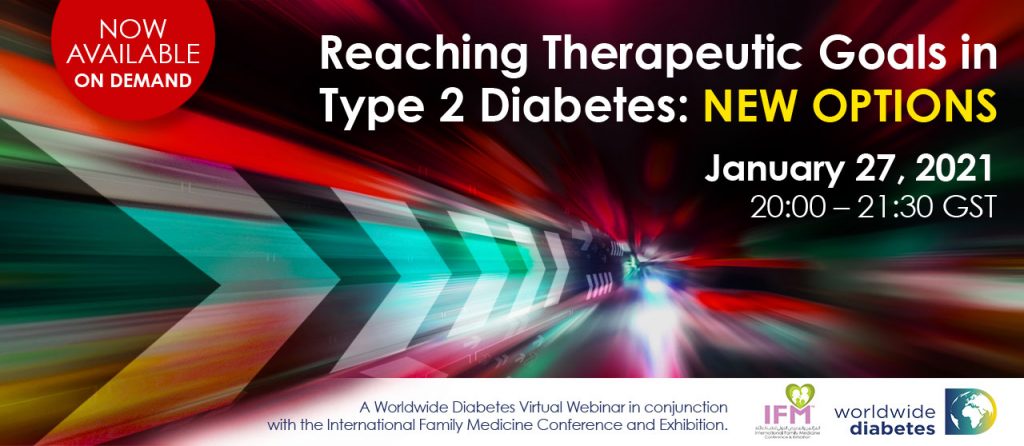
< Back to Blog Listing and Webinar Information
Fixed-dose Combinations in the Management of Type 2 Diabetes

Abdullah Bennakhi, MD
Kuwait City, Kuwait
01/13/2021
Research conducted over the last several decades has resulted in an improved understanding of diabetes pathophysiology and the development of an array of antihyperglycaemic medications.1 Yet diabetes remains pervasive and has immense public health consequences.2 Moreover, despite the availability of a number of treatment options, hyperglycaemia is often still poorly controlled.3 This situation chiefly reflects the limitations inherent in current monotherapy treatment options for type 2 diabetes, as well as clinical inertia.
To better understand how we can improve care for people with diabetes and hyperglycaemia, it is helpful to review some recent findings. In 2015, one study showed that the median time for treatment intensification after A1c measurements above target ranged from 0.3->7.2 years despite the risks associated with delaying glycaemic control.4 Several investigations have stressed the importance of early treatment to prevent both small vessel disease complications and cardiovascular (CV) events.5 It’s important to note that because type 2 diabetes is a progressive disease in many patients, maintenance of glycaemic targets with monotherapy may only be possible for a few years, after which combination therapy becomes necessary. Intensification of treatment should not be delayed and should be based on shared decision-making between physician and patient. Important clinical considerations include the presence of established atherosclerotic cardiovascular disease (ASCVD) or indicators of high ASCVD risk, heart failure, chronic kidney disease (CKD), other comorbidities, and risk of specific adverse drug effects, as well as safety, tolerability, and cost.6
One important way to address the need for more effective management of diabetes is with the use of combination products that simplify regimens; this option may be especially useful for patients taking multiple medications. A meta-analysis of nine studies of patients with chronic diseases, including diabetes and hypertension, was conducted to compare medication compliance with fixed-dose combination (FDC) vs free-drug component regimens. A 26% relative risk reduction in noncompliance was seen in the FDC group.7 Another analysis of patients with type 2 diabetes who took either FDC or a combination of single pills showed increased compliance, improved satisfaction, and lower direct medical cost in the FDC group.8 Fixed-dose combinations of oral hypoglycaemic agents appear to significantly reduce HbA1c and fasting plasma glucose values, thereby efficiently reducing hyperglycaemia in patients in whom monotherapy fails. Improved adherence to FDCs and the absence of serious adverse drug reactions compared with dual therapy play an important role in decreasing the incidence of hyperglycaemia in patients with type 2 diabetes.9
A wide range of fixed-dose combinations is available in many parts of the world. Most of these formulations contain metformin with an agent in one of the newer classes of antidiabetic drugs; either a dipeptidyl peptidase 4 (DPP-4) inhibitor or a sodium glucose cotransporter 2 (SGLT-2) inhibitor. Other combination products may include older sulphonylureas and thiazolidinediones (TZDs), agents that are commonly prescribed when metformin alone fails. Combinations of long-acting insulin analogues and glucagon-like peptide-1 (GLP-1) agonists are frequently used as well.
Are you prescribing FDC for your patients with diabetes? Which agents are you prescribing and what are your impressions of the relative efficacy of the options that are available? Let us know in the comments section below and be sure to join us for further discussion of this subject during the upcoming webinar, Reaching Therapeutic Goals in Type 2 Diabetes: New Options.
Register and Access the On-Demand Webinar
COMMENTS
REPLIES
There are no comments on this post yet.
- Management of Hyperglycaemia in Type 2 Diabetes, 2015: A Patient-Centered Approach: Update to a Position Statement of the American Diabetes Association and the European Association for the Study of Diabetes. Diabetes Care. 2015;38(1):140–9.
- Centers for Disease Control and Prevention. Diabetes Report Card 2014. Atlanta, GA: Centers for Disease Control and Prevention, US Dept of Health and Human Services; 2015. https://www.cdc.gov/diabetes/pdfs/library/diabetesreportcard2014.pdf
- Ali MK, Bullard KM, Saaddine JB, et al. Achievement of goals in U.S. diabetes care, 1999–2010. N Engl J Med. 2013;368(17):1613–24
- Khunti K, Gomes MB, Pocock S, et al. Therapeutic inertia in the treatment of hyperglycaemia in patients with type 2 diabetes: A systematic review. Diabetes Obes Metab. 2018;20:427-437.
- Hayward RA, Reaven PD, Wiitala WL, et al. Follow-up of glycemic control and cardiovascular outcomes in type 2 diabetes. N Engl J Med. 2015;372(23):2197–206.
- American Diabetes Association. 9. Pharmacologic approaches to glycemic treatment: Standards of Medical Care in Diabetes—2021. Diabetes Care. 2021;44(Suppl. 1):S111–S124.
- Bangalore S, Kamalakkannan G, Parkar S. Fixed-dose combinations improve medication compliance: a meta-analysis. Am J Med. 2007;120(8):713-719.
- Hutchins V, Zhang B, Fleurence RL, et al. A systematic review of adherence, treatment satisfaction and costs, in fixed-dose combination regimens in type 2 diabetes. Curr Med Res Opin. 2011;27(6):1157-1168.
- Vijayakumar TM, Jayram J, Cheekireddy VM, et al. Safety, efficacy, and bioavailability of fixed-dose combinations in type 2 diabetes mellitus: A systematic updated review. Curr Ther Res Clin Exp. doi.10.1016/j.curtheres.2017.01.005.